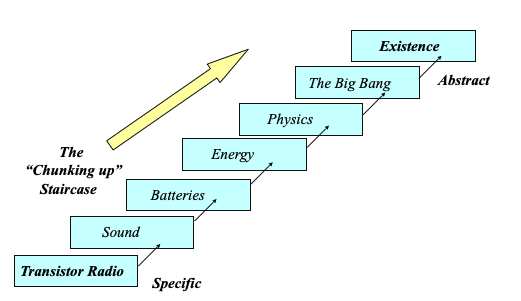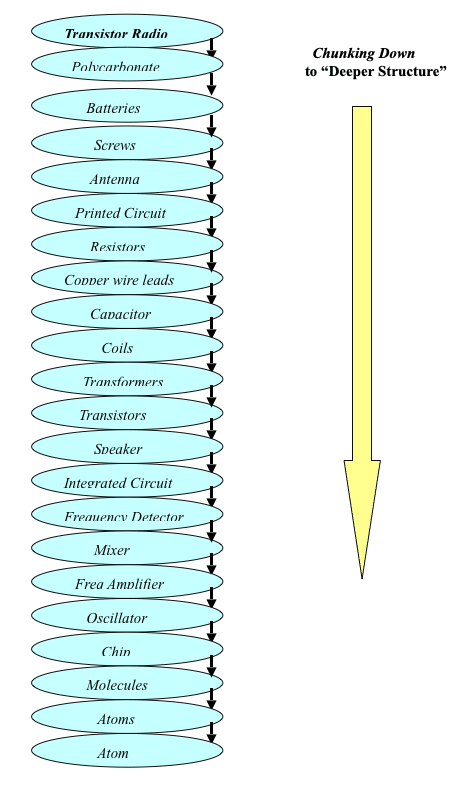I don’t like to get too specific about lyrics. It places limitations on them and spoils the listener’s interpretation – David Gilmour
I always wanted to be somebody, but now I realise that I should have been more specific – lily Tomlin
The Hierarchy of Ideas is a concept that gives a detailed account of how to control the flow of linguistic conversations, or ideas – thus supplementing the pursuit of excellence with regard to mastering the art of communication. “Chunking” is a phrase that is associated to the concept of the “Chunk” – which originated in the world of computer programming. This should come as no surprise considering Richard Bandler’s previous experience in that particular field! In NLP the term “Chunking” refers to a group of pieces of interrelated information that can be organised, then expanded upon in either a deductive (logical) or inductive (broader generalisation) direction through the use of language. The recipient of the information, or Chunk, will usually be required to determine what the exact nature of the interrelated information is. Therefore Chunking in this way allows for language to be used as the catalytic spark that ignites a process of expansive exploration for either higher meaning (Chunking up), or specific clarification in relation to the missing information in the initial message (Chunking down). Information can be, by its very nature, very expansive…it can be very simple (exact), or very complicated (abstract) depending on how it is Chunked. It may simply consist of one word, or a phrase, a sentence or more. By using Chunks relationships between the component parts can be defined; after all something will never be general, specific, huge, tiny, good or bad by itself – it requires a context, a relationship to the other pieces of the chunk to frame and define it. Consider this – nothing has any meaning in isolation.
As no two people share the exact same reality, each individual will Chunk individually! That is to say that each person will make their own preferred connotations dependant upon the patterns, correlations, similarities and differences that they perceive in their model of the world. So, the ability to think creatively in relation to the amount of meaningful patterns that can be perceived between pieces of organised information will determine the boundaries of a person’s ability to chunk effectively; and ability to understand. Some people will prefer to use small details and component parts as a foundation, and then subsequently assemble large wholes; other may be analytical, initially examining the whole before dissecting it into its parts. As was previously explored in module 10 of this training, the Milton Model, which uses abstract, ambiguous and vague meanings, is an excellent example of chunking up; this facilitates trance and an inner transderivational search for meaningful significance. The Meta Model is of course an equally good example of chunking down; ambiguous and vague meanings being explored, examined, clarified and eventually defined.
When used effectively Chunking is a highly effective and useful tool in communications, mediations and negotiation. An effective communicator can carefully facilitate rapport, agreement, persuasion and create convincing mutual understanding by listening to (and eventually influencing) the level or way that another person is operating on. Chunking can be very helpful when searching for a joint agreement or solution when mediating, or negotiating; it should be noted however that it is important to remain in the third perceptual position when doing so. When done properly this will usually lead to agreement, which in this context can be defined as a situation of reaching concord or harmony between individuals – a pact or “win, win” situation. Indeed theoretically, if you chunk up enough you should always find eventual agreement, even if at an existential level. Once this has been achieved then the fine details of the agreement can be ascertained by simply chunking down. As can be seen, the effective use of Chunks will not only undoubtedly help towards excellent communication with others on a day to day basis, but also facilitate agreement, influence, understanding and benevolence between therapist/practitioner, clients and their significant others..
Chunking up
When chunking up a specific concept, object, thing etc is moved towards being more general. This can allow for a broader view, or put things into a new context. Also, small, simple parts can be synthesised and moved up into a larger concept;
- From a part to a whole – Spoke = Wheel = Frame = Bicycle
- From an example of a larger category to that very larger category itself – Daisy = flower = Plant = Flora = Living Organism
In simple terms chunking up creates more choices and options and encourages expansive lateral mental thought….seeing the bigger picture! Milton model processes work beautifully in relation to this.
Chunking down
When chunking down a general concept or general relation to an object or thing etc is moved towards being more specific; thus the surface structure is penetrated and the deeper structure examined. Small parts can be sub-divided and clarified.
- From a whole to a part – Bicycle = Frame = Wheel = Spoke = Aluminium
- From a larger category to an example of that larger category – Aircraft = Rotorcraft = Helicopter = Focke-Wolf = FW 61
This can be classified as analytical, and helps with understanding the relation of parts to the whole. The Meta model is the perfect process for this.
Chunking across
Additionally, chunks can be used to traverse one member of a class to another related member on the same level of that class; or part of a whole to another component part of the same whole.
- Member of a class to another member – Bus = Taxi = Train = Tram = Ferry (all modes of public transport).
- Part of a whole to another part – Button = Pocket = Belt = Seam= Zip (all parts of a pair of trousers).
Chunking across is akin to promoting free association; that is to say that connections can be made between objects that initially appear to have no relation to each other.
Chunking Phrases;
When considering the type of phrases that can be used when chunking, it becomes apparent that the list would never be exhaustive. Here are just some of the phrases that can be used for the purposes of Chunking up;
- “You say you are depressed, how then are the ways, do you realise, that other depressed people can begin to feel happy again?”
- “If you don’t like your job, tell me what can people, like you, can do about it?”
- “See the sea…and see the sea sailors in their boats as you look, and see, what does a sailor get from sailing on the sea…what other examples can you think of that water be usefully used for…wellness?”
- “How can a Transistor Radio affect the feelings and well being of a listener as they both listen, or not, but are…?”
- “What is the purpose of young children who take pleasure from exploring simple things…and how it can help you in your situation?”
- “I often wonder if lions lie as they are lying with lions in the sun…if they did would lying lions lie like people sometimes do? What kind of intention do lies have…?”
- If a person does the wrong things for the right reasons, are their intentions then noble…?”
- “Some people seem to change when they get behind the wheel of a car, what are your thoughts on the modern day driver of today?”
- “It’s not what you know that you don’t know that causes you problems; it’s what you don’t know that you know…now, how does knowing that that apply to you right now?”
- “As I say the word school do you have childhood memories? What is the purpose of that memory now? What can you take from that memory?”
And here is a list of phrases that can be used for the purposes of Chunking Down;
- “Okay then, can you tell me exactly what it is that makes you feel that you are depressed?”
- “What precisely prevents you from applying for other jobs and changing your profession?”
- “Yes, water does indeed have many uses, but I actually want you to tell me which day of the week it is that you swim at your local swimming club to keep fit…and how many lengths you actually swim!”
- Transistor radios are useful in the home….but do you have one in your office? Where is it situated and what channel do you listen to?”
- “How many children do you have, how old are they and what are their names?”
- “Please give me an example of when you have lied to him. What exactly prevented you from telling your husband the truth at that time?”
- “Who exactly decides what is right and wrong? Can you give me an example of what doing the right thing for the wrong reason is? Thanks, now please tell me exactly how you have decided that it is a noble action”
- “What kind of car do you drive? Have you been involved in a driving incident lately? If so where did it happen?”
- What prevents you from tapping into your inner resources to solve the problem of how to change that plug fuse? You have after all done it before several times!”
- “Can you tell me the name of the primary school that you attended and the name of your best friend in primary five?”
The contrast between the chunking up and chunking down phrases above offers a concise, simplistic illustration of the practical application of this set of skills. Now that I have learnt about chunking I am becoming ever more surprised by the amount of possibility it offers me in my every day interactions. The Hierarchy of Ideas undoubtedly facilitates the art of excellent communication, intervention and the removal of blockages.
Chunking is indeed everywhere….. (Where exactly?).
Learn more about the amazingly influential use of language patterns in our NLP Training Courses


